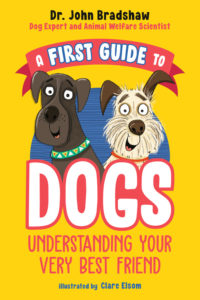“What is it Like to be a Dog?”
My middle-schooler grandkids love their superheroes. Posters of their favorites adorn their bedroom walls, their T-shirts feature costumed crusaders extolling their superpowers. Yet few parents realize that the family dog has his or her own set of superpowers, not so flashy as those of their two-legged fictional counterparts, but, in their own way, just as enthralling. If only more people would take the time to wonder, “what is it like to be a dog?” (or, indeed, any other animal).
Imaginary worlds are the very stuff of childhood, and nowadays we have the knowledge to stretch children’s imaginations to include the worlds of animals as well as humans and their ilk. Over the past hundred years or so, science has revealed just how many differences there are between reality as we know it, and the many parallel but distinctive realities inhabited by other animals. The family dog is probably the most accessible example, but any animal could serve, whether the family cat, a small furry, or even a bird perched on a wire outside an apartment window. Any one of these could lead to valuable insights into how the animals around us live in their own worlds.
Dogs make great subjects for such flights of fancy, and not only because they’re so familiar to us. Their version of the family home overlaps with ours a lot – otherwise we’d find them difficult to live with, and vice versa – but there are also many intriguing differences that I reveal in my book for middle-graders, “A First Guide To Dogs”. Dogs can hear high-pitched sounds that we can’t, they’re red-green color-blind and permanently long-sighted, their sense of smell is thousands of times better than ours, and they have a whole other “nose” that sits between their actual nose and the roof of their mouths, that helps them to decode – and perhaps store – the individual smells of other dogs. Indeed, dogs’ social lives revolve around these smells, hence the care with which they choose a place to pee, and their obsession with sniffing underneath each other’s tails.
It’s not only the physical world that must seem different to a dog. Their minds work differently too, even though their brains are laid out in a similar way to ours. Scientists are still arguing about whether dogs are aware of themselves to the same extent that we are (probably not so much), but we are now sure that their sense of time is different to ours. Dogs live much more in the here-and-now than we do, having only a limited perception of the past and even less of a grasp of the future. This has profound implications for the way they interpret our actions. Most pertinently, they seem unable to understand that whenever we leave the home, they should expect us to return. Left home alone, many dogs fear they have been abandoned for good, raising their stress levels sky-high. A simple training regime can overcome this, but too few owners understand the necessity.
Dogs’ lives can also provide great lessons for thinking about what “well-being” really means. Hold on, surely everyone loves their dog, right? But that’s no guarantee that dogs will always get the happiness they deserve. The problems come when dogs get treated as if they were just little people, not animals with their own priorities. How would middle-schoolers feel if their parents ripped their screens out of their hands every time they saw a message from a friend? Yet that’s exactly what dogs must experience when they’re yanked away from every interesting smell by the leash tightening around their neck.
Dogs – and other animals – can provide a springboard for amazing journeys into other worlds, now that science has given us so much insight into their minds and how they interpret their surroundings. Thinking about dogs, especially, can give us a close-to-home stimulus for the imagination, whether the focus of the class is science, or ethics, even creative writing.
Published June 13th, 2023 by Penguin Workshop
About the Book: Featuring fun illustrations (by Clare Elsom) and easy how-tos from animal expert Dr. John Bradshaw!
Uncovering the secret lives of pets, Dr. John Bradshaw invites young readers to learn more about their closest companions: their dogs! Told from the point of view of Rusty the Terrier, this lively, illustrated book gives kids a front-seat view to the everyday lives of dogs, sharing lessons and growing children into the best pet owners they can be.
★ “Perceptive and engaging—essential reading for anyone seeking greater understanding of their four-legged best friends.” — Kirkus, starred review
About the Author: John Bradshaw is the director of the Anthrozoology Institute at the University of Bristol in the U.K. He has studied the behavior of domestic cats and dogs for more than 25 years.
Thank you, John, for this fun look into the minds of dogs!



1 thought on “Author Guest Post: “What is it Like to be a Dog?” by Dr. John Bradshaw, Author of A First Guide to Dogs: Understanding Your Very Best Friend”